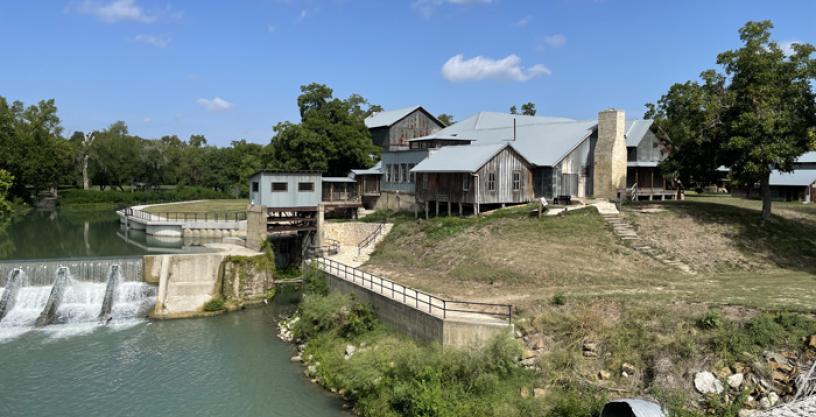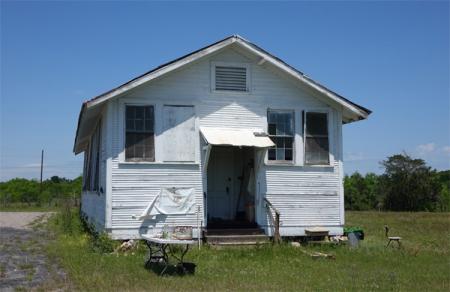Monuments and Buildings of the Texas Centennial
The 1936 Texas Centennial was the first statewide, systematic effort by Texans to commemorate historical
events, places, and people. Centennial organizers used the year 1836, when Texas became an independent republic from Mexico, as a symbolic starting point for a broad celebration of the state’s history and industry. The celebration produced some of Texas’ most recognized landmarks—the San Jacinto Monument, Alamo Cenotaph, and expositions buildings in Dallas and Fort Worth—along with hundreds of other commemorative properties in 250 Texas counties.
Between 1935 and 1939, the Commission of Control for Texas Centennial Celebrations implemented a statewide program to plan and construct more than 1,100 properties—buildings, markers, and public art—to honor Texas’ 100th anniversary of independence. The massive undertaking benefited from an organizational structure that involved political leaders, state agencies, historians, artists, architects, craftsmen, and ordinary citizens. However, the monument-building process was constrained by limited resources and complicated by political interests that competed against historical and cultural values. Thus, the Centennial commemorative properties were imbued with a historical narrative that communicated that generation of Texans’ desired identity as much as the actual history they memorialized.
In 2018, the National Park Service approved THC’s “Monuments and Buildings of the Texas Centennial” Multiple Property Form that included a historic context for the 1936 statewide commemorative program and an inventory of associated properties. Beginning in 2018, several Centennial commemorative properties in Texas were individually listed in the National Register of Historic Places (NRHP), and nominations for others are in process. Links to nominations will be added to this page as they are approved.
Multiple Property Form and Nominations Approved by the NPS
- Monuments and Buildings of the Texas Centennial (Multiple Property Form approved April 2018)
- Henry Smith Statue, Brazoria, Brazoria County (listed October 2018)
- Camp Colorado Replica, Coleman, Coleman County (listed April 2018)
- Pioneer Woman Monument, Denton, Denton County (listed April 2018)
- DeWitt County Monument, Cuero, DeWitt County (listed February 2019)
- Erath Memorial Arch, Stephenville, Erath County (listed April 2018)
- Mier Expedition and Dawson's Men Monument and Tomb, La Grange, Fayette County (Listed February 2019)
- Jackson County Monument, Edna, Jackson County (listed April 2018)
- Matagorda County Monument, Bay City, Matagorda County (listed April 2018)
- San Patricio de Hibernia Monument, San Patricio, San Patricio County (listed April 2018)
- Sons of San Patricio Monument, San Patricio, San Patricio County (listed April 2018)
- La Salle Monument, Indianola, Calhoun County (listed July 2018)
- Amon B. King’s Men Monument, Refugio, Refugio County (listed July 2018)
- Mission Nuestra Senora del Refugio Monument, Refugio, Refugio County (listed July 2018)
- Victoria County Monument, Victoria, Victoria County (listed July 2018)
- Ben Milam Statue, San Antonio, Bexar County (listed August 2020)
Researching Centennial Properties in Texas
- The Multiple Property Form: “Monuments and Buildings of the Texas Centennial” provides the history of the statewide program to plan and execute Centennial projects, annotated bibliography, an overview of associated property types, and an inventory.
- The Texas Historical Commission offers guidance on restoring Centennial historical and highway markers.
- Some properties associated with the statewide Centennial are listed in the NRHP as contributing and noncontributing properties within historic districts or on the property of a listed building. For assistance determining the contributing status of a Centennial property in a listed district or individual property, please contact THC’s National Register Coordinator.
Mission 254: National Register Listings for Every Texas County
Since 1969, the Texas Historical Commission has assisted with the preparation and processing of National Register nominations. Most of these were initiated at the local level, by property owners, county historical commissions, preservation groups, and Texas Main Street and Certified Local Government programs. 26 Texas counties, however, have no properties listed in the National Register, but each one has properties that meet the criteria for listing, including: historic houses and residential neighborhoods; county courthouses and other public buildings such as schools and city halls; and downtown districts that include commercial, civic, and religious buildings.
The National Register program in Texas is still driven by local initiative, and our staff is happy to work with any and all applicants who wish to gain national recognition for the historic properties they value, as long as they meet at least one of the National Register criteria and retain a good degree of integrity. We invite residents and property owners in these 26 counties to identify and nominate your local historic treasures. For more information, contact Greg Smith, the National Register Coordinator.
| Bailey | Gaines | Sherman |
| Baylor | Haskell | Stonewall |
| Borden | Jim Hogg | Swisher |
| Castro | King | Terry |
| Cochran | Lamb | Titus |
| Crane | McMullen | Upton |
| Delta | Moore | Ward |
| Duval | Reeves | Yoakum |
| Foard | Scurry | |


